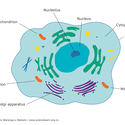Biotechnology has helped improve the quality of people’s lives for over 10,000 years. Today’s biotechnologies vary in application and complexity. However, they all have potential to change our society.
Biotechnology aims to benefit society
- The fundamental aim of biotechnology is to meet human needs or demands in order to improve our quality of life.
Ancient biotechnologies mainly aimed to provide a more reliable food source by growing plants and domesticating animals rather than depending on hunting and gathering. Over the last century, the number and range of biotechnologies have rapidly increased. A key to this increase was the discovery of the structure of DNA in 1953, leading to numerous applications, particularly in forensics1, medicine and agriculture.
Read our article, Modern biotechnology for further information.
Biotechnology impacts depend on many factors
As our knowledge and capability in biotechnology increases, so do the potential benefits. However, while the intention behind new biotechnologies is to benefit society, determining what impact a particular biotechnology may have is complex.
You need to consider a number of interacting factors:
Issues specific to a particular biotechnology
Different biotechnologies have different issues to consider, review these articles Ethics and xenotransplantation, Ethics and zebrafish and RNA interference.
People’s different needs and values
People’s needs, values and priorities vary, leading to differing views of how a particular biotechnology may impact on them.
Some people hold strong moral and ethical views on particular practices based on their religious and cultural beliefs. Biotechnologies involving practices such as organ transplants, manipulating human embryos and using animals in research may be particularly offensive to some groups of people. Their views are likely to affect progress and availability of some biotechnologies in different societies. These two articles Ethics and organ donation and Designer babies – fact or fiction? could be used to help generate discussions in the classroom.
Geographic location
Historical context
Biotechnologies are developed in response to society’s needs and demands at that particular time. People are often reluctant to accept new biotechnologies initially, but over time, they tend to become more widely accepted.
New biotechnologies are often controversial
Biotechnology developments are often controversial because of the ethical issues they raise. They frequently become the subject of public debate. Sometimes, people are wary of new biotechnologies because they involve doing things that haven’t been done before, and they are unsure of possible future effects. It’s also important to include te ao Māori considerations, which may be affected by the new technology. Public debate raises the issues and presents different viewpoints. This can help people make informed decisions and also influence government organisations that control2 new research and development.
Regulations help minimise risk
As new biotechnology discoveries are made, governments develop regulations, legislation and guidelines to minimise risk to people and the environment. In New Zealand, the Environmental Risk Management Authority (ERMA) is the government organisation that regulates and manages risk concerning new organisms. ERMA was disestablished in June 2011 and its functions were incorporated into the Environmental Protection Authority (EPA).
New Zealand organisations involved in research have their own ethics committees to ensure research involving humans and animals meets ethical guidelines.
Making ethical decisions
Making decisions about new biotechnology developments is not easy. Using different ethical frameworks can help you consider the issues and make informed decisions. Try using the Ethics thinking toolkit to help you explore an ethical issue.
See the video Common ethical frameworks.
Related content
Scientists have learned how to control gene expression3 via a process called RNA interference4. This biotechnology tool has applications in human medicine, agriculture, horticulture and pest management. RNA interference – a context for learning provides curriculum information and pedagogical insights.
Useful links
DNA from the beginning – simple explanations of the concepts of DNA5 and the chronological development of scientific understanding, including animations, video and audio.
The clone zone – timeline showing the development of cloning from 1885–2002.
Visit the Environmental Protection Authority (EPA) website.
National Conversations on Genetic Technologies for Environmental Purposes – 2024 report from New Zealand's Biological Heritage National Science Challenge.
- forensics: The use of scientific techniques and evidence to solve crimes used in the legal system.
- control: 1. Part of a scientific experiment in which no treatment has been applied in order to see whether there are any detectable differences to the experiment that did receive a treatment. 2. To hold in check or to curb.
- gene expression: The use of a gene to make a protein. Involves transcription of the DNA sequence into RNA and translation of the RNA into an amino acid sequence (or protein).
- RNA interference (RNAi): The process when a double-stranded RNA molecule prevents a messenger RNA (mRNA) molecule from being translated into a protein. Also called RNA silencing or RNA inactivation.
- DNA: Deoxyribonucleic acid (DNA) is a molecule that contains the instructions needed for an organism to develop and function. These instructions are stored as a code made up of four chemical bases: adenine (A), guanine (G), cytosine (C) and thymine (T).









